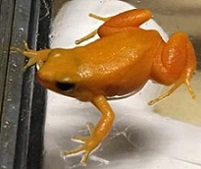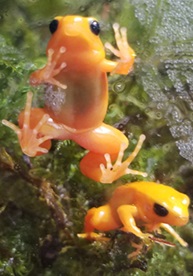Golden Mantella frogs
Mantella aurantiaca
- Habitat: Humid rainforests around Pandanus swamps
- Range: Central Madagascar
- Natural Diet: Insects (flies, ants and termites) and spiders
- Status in the Wild: THREATENED
All about the Golden Mantella Frogs
Golden Mantella Frogs are small frogs that are bright golden-orange in color. They use their bright color as an anti-predator strategy warning their predators that they are toxic. They also secrete toxic chemicals that deter predators. Their eyes are oval-shaped and black in color. They have small sticky circular pads on their fingers and toes that help them to hold on to smooth surfaces when they climb. Their skin has fascinating properties – it helps them breathe, absorbs water (through osmoregulation), and helps control body temperature. They have long fingers and toes with rounded tips. Although males and females are similar in color, the males are smaller in size. They are one and a half inches long.
Diet/ Habitat/ Range
Golden Mantella Frogs are native to and only found in Madagascar (endemic) living in wetlands in humid forests located in the central-east area. They mostly feed on insects (insectivorous) such as termites, ants, fruit flies, and some other invertebrates, fruits, pollen, and nectar. They are omnivorous mainly feeding on aquatic invertebrates, fish, and pond vegetation. Young Golden Mantella Frogs are carnivorous predominantly feeding on aquatic invertebrates.
Behavior
Unlike mammals, Golden Mantella Frogs cannot thermoregulate. In the cold winter months, they predominantly remain inactive. When the climate starts warming up in spring, they emerge and are more active. They are active during the day (diurnal) and they live in groups that have been observed to have more males than females. Both sexes are territorial during the breeding season and are known to push their competition away.
Reproduction
Golden Mantella Frogs breed from spring to summer. These frogs emerge in spring and use the wetlands was breeding. Males emit vocalizations to attract females. During breeding, males climb on top of females holding them with their forelimbs. This mating position is called amplexus. The males possess unique pads on their thumbs that when pressed against the females, motivate them to lay eggs. Eggs are laid in either a moist or wet environment such as a pond, stream, or wetland. Unlike birds, amphibian eggs are fertilized externally. Females lay clutches of 12 to 30 eggs. Unlike mammals and birds, Golden Mantella Frogs similar to other frogs do not take care of their young. Their eggs hatch into tadpoles, their larval stage. Through complete metamorphosis, tadpoles transform into frogs.
Conservation/Status
The most significant threat to the wild populations of Golden Mantella Frogs is the loss of their natural habitat mainly due to agricultural practices, logging and timber extraction, illegal hunting and trapping for the pet trade, mining, and expansion of human habitations. These threats have led to the severe fragmentation of their habitat isolating wild populations and reducing their numbers. Invasive species such as the Asian Common toad that competes with Golden Mantella Frogs for their food resources have also resulted in a population decline. Since Golden Mantella Frogs are only found in Madagascar, the International Union for the Conservation of Nature has categorized them as ENDANGERED.


.jpg)

